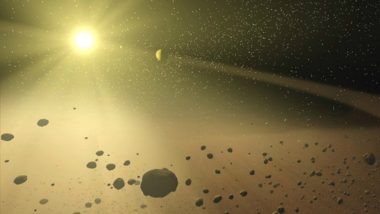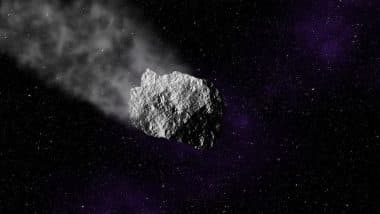Asteroids keeping passing through the universe every now and then. These space rocks keep flying by the Earth's atmosphere and one more is set to pass closely by the Earth on May 15. An asteroid referred to as Asteroid 2010 WC9 will pass by the Earth at a distance of half the lunar distance. According to EarthSky, it will fly past our planet at about 28,655 miles per hour. Size wise it is quite a large one, about 60 to 130 meters. But if you are wondering if it poses any threat to us, then none.
Asteroid 2010 WC9 was ‘lost’ one, and it was found again. The Catalina Sky Survey in Arizona first detected it on November 30, 2010. Astronomers watched it until December 1, but it became too faint to see. The space rock has completed its orbit and will return to the Earth eight years later. At 11.05 pm on Tuesday, Asteroid 2010 WC9 will make its closest approach from Earth. It is a safe passing distance and will cause no harm.
EarthSky shared information about the asteroid:
'Lost' asteroid to pass closely May 15:https://t.co/GReylBTMIr
Asteroid 2010 WC9 will pass at about half the moon's distance, in one of the closest approaches ever observed of an asteroid of this size.
Click in for information about viewing online. pic.twitter.com/QBNXQ036wd
— EarthSky (@earthskyscience) May 12, 2018
Astro enthusiasts and sky observers can watch the asteroid pass through. Despite its big size it will not be visible to the naked eye but watching it from a telescope could help for some people. If you do not have a telescope and still enthused about watching the rock fall by, then there is a live streaming from Northholt Branch Observatories in London. The observatory will conduct a live stream session on Facebook. So if you are deeply interested in the space rock flybys, then you can tune into the facebook page. Although it will be a session of just about 25 minutes. Talking about the asteroid Guy Wells of the observatory said, “The broadcast will last less than 25 minutes, since the asteroid will cross our field of view during this time period. The asteroid will move pretty fast (30 seconds of arc per minute). Our display will be updated every five seconds. We, of course, collect astrometric data while this happens, but the movement of the asteroid will occur every five seconds." Asteroid 2010 WC9 is not among the potentially hazardous asteroids marked by NASA. A true enthusiast can almost enjoy watching it live.
(The above story first appeared on LatestLY on May 14, 2018 11:31 PM IST. For more news and updates on politics, world, sports, entertainment and lifestyle, log on to our website latestly.com).













 Quickly
Quickly




















